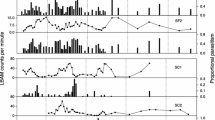Abstract
The pine beauty moth, Panolis flammea, is a defoliating pest of lodgepole pine (Pinus contorta) forests in Scotland. This article reviews early and recent research on the population ecology of Panolis flammea and presents an analysis of pupal survey data collected between 1977 and 1993. Research in the 1980s suggested that natural enemies, although effective in preventing P. flammea outbreaks on Scots pine (Pinus sylvestris), played an insignificant role in the population dynamics of P. flammea on lodgepole pine. However, analysis of pupal survey data showed that delayed density-dependent action of natural enemies, probably parasitoids, was overlooked during the 1970s and 1980s. Recent research suggests that fungal pathogens are responsible for a decline in the frequency and severity of outbreaks of P. flammea on lodgepole pine. This suggestion, together with the overlooked importance of other natural enemies, indicates that the population ecology of P. flammea in Scotland has changed during the past 20 years and requires a full reappraisal.
Similar content being viewed by others
Author information
Authors and Affiliations
Additional information
Received: May 31, 1999 / Accepted: August 18, 1999
Rights and permissions
About this article
Cite this article
Watt, A., Hicks, B. A reappraisal of the population dynamics of the pine beauty moth, Panolis flammea, on lodgepole pine, Pinus contorta, in Scotland. Popul Ecol 42, 225–230 (2000). https://doi.org/10.1007/PL00012001
Issue Date:
DOI: https://doi.org/10.1007/PL00012001




